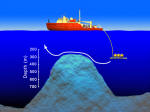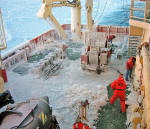|

from
National Science Foundation Website
|
ARLINGTON,
Va.—Scientists working in the stormy and inhospitable waters
off the Antarctic Peninsula have found what they believe is
an active and previously unknown volcano on the sea bottom.
The international science team from the United States and
Canada mapped and sampled the ocean floor and collected
video and data that indicate a major volcano exists on the
Antarctic continental shelf, they announced on May 5 in a
dispatch from the research vessel Laurence M. Gould, which
is operated by the National Science Foundation (NSF).
NSF is an independent federal agency that supports
fundamental research and education across all fields of
science and engineering, with an annual budget of nearly
$5.58 billion. NSF manages the U.S. Antarctic Program, which
coordinates U.S. scientific research on the southernmost
continent and in the Southern Ocean.
Evidence of the volcano came as an unintended bonus from a
research plan to investigate why a massive ice sheet, known
as the Larsen B, collapsed and broke up several years ago.
Scientists hope to understand whether such a collapse is
unique or part of a cycle that extends over hundreds of
thousands of years.
Scientific evidence the team collected also corroborates
mariners’ reports of discolored water in the area, which is
consistent with an active volcano.
Eugene Domack, a researcher at Hamilton College in Clinton,
New York and the expedition’s chief scientist, said the
volcano stands 700 meters (2300 feet) above the seafloor and
extends to within roughly 275 meters (900 feet) of the ocean
surface.
He estimated that the volcanic cone contains at least 1.5
cubic kilometers (.36 cubic miles) of volcanic rock.
By comparison, Mount Erebus, a known active volcano on
Ross
Island near McMurdo Station, NSF’s main Antarctic research
center, is approximately 3,800 meters (12,400 feet) above
sea level. |

An artist’s
depiction of the track of the camera array as it is towed
over the volcanic cone.
Credit: Trent Schindler / National Science Foundation |
|

The underwater
video array is prepared for deployment.
Credit: National Science Foundation / Hamilton College |
|

The icy deck of
the Laurence M. Gould.
Credit: NSF / Hamilton College |
Hawaii’s Mauna Loa, the largest volcano on Earth, rises
approximately 4,100 meters (13,600 feet) above sea level. Mexico’s
Cuexcomate volcano is considered to be the world’s smallest,
standing 13 meters (43 feet) tall.
The research team comprised scientists from Hamilton College,
Colgate University, the Lamont-Doherty Earth Observatory at Columbia
University, Montclair State University in New Jersey, Southern
Illinois University in Carbondale and Queens University in Canada.
Domack said the volcano lies in an area known as Antarctic Sound, at
the northernmost tip of Antarctica.
He noted that there has been "no previous scientific record of
active volcanoes in the region" where the new peak was discovered
and that it is north of an existing boundary where volcanic activity
is known to occur in the region.
The volcano, which has yet to be named, also is unusual,
Domack
said, in that it exists on the continental shelf, in the vicinity of
a deep trough carved out by glaciers passing across the seafloor.
Sonar maps made of the seafloor during a research cruise in January
2002 first suggested that the volcano exists. The so-called swath
maps showed a large concentric and symmetrical feature on the ocean
floor that had not been scoured by the advance and retreat of
glaciers. The absence of glacial scours indicates the suspected
volcano is fairly young in geologic terms.
But it was not until April of this year that scientists were once
again able to venture into the region to examine the evidence
further.
In addition to mapping, the research team used a bottom-scanning
video recorder, rock dredges, and temperature probes to survey the
sides and crest of the submarine peak. The video survey revealed a
surface that is heavily colonized by bottom-dwelling organisms.
But a dark mat of underwater life is broken along the edges of the
volcano by barren patches of dark, black rock indicating that lava
has flowed there. Because no life was found on these surfaces, the
rock is believed to have formed fairly recently in geologic time.
Rock dredges recovered abundant, fresh, basalt, which normally would
be rapidly acted upon and transformed by seawater but appeared
unaffected.
Highly sensitive temperature probes moving continuously across the
bottom of the volcano revealed signs of geothermal heating of
seawater. The heating was noticed especially near the edges of the
feature where the freshest rock was observed.
These observations, along with historical reports from mariners of
discolored water in the vicinity of the submerged peak, indicate
that the volcano has been active recently.
Domack said expects that there will interest among other scientists
to return to the area and study the peak in more detail.
"None of us on this cruise," he noted, "are experts in volcanoes."
|